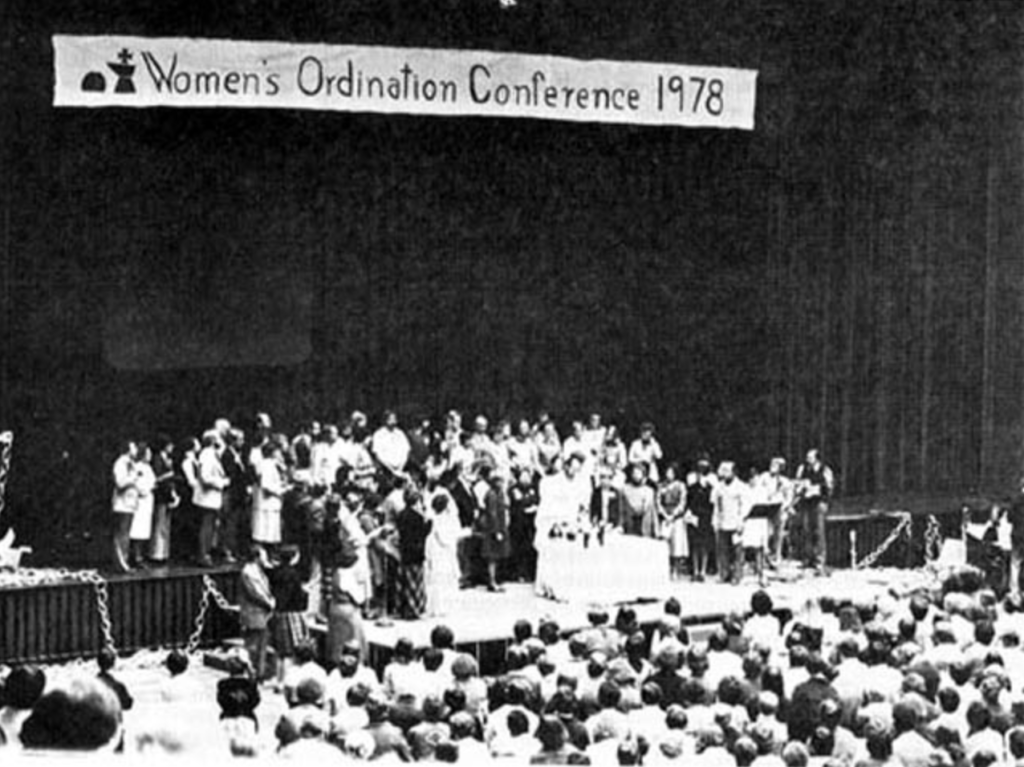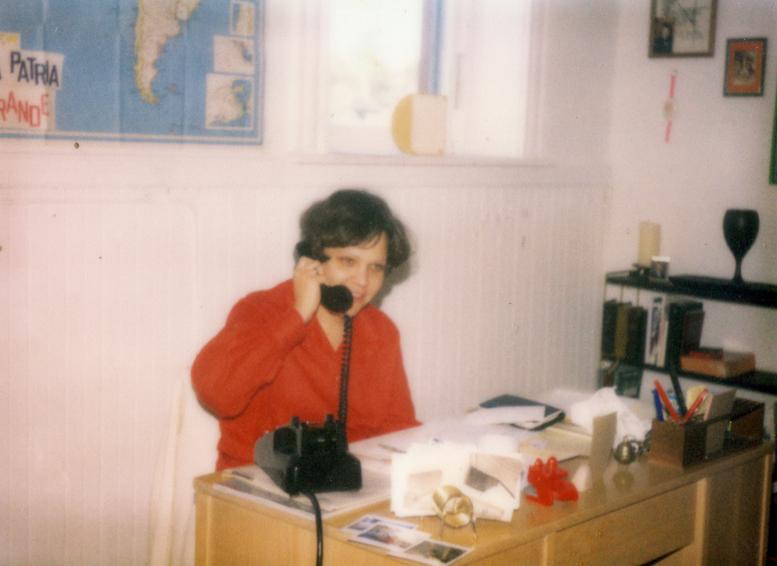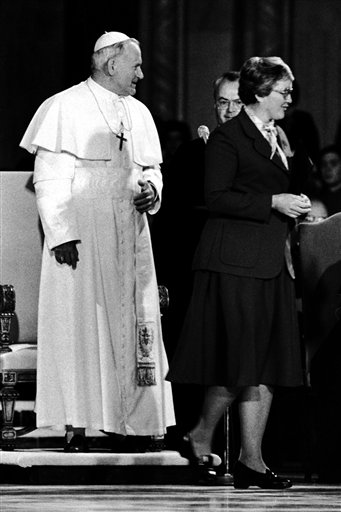Prophetic Witness during Pope John Paul II’s 1979 Visit to the U.S.
Beginning on Saturday, October 6th, 1979, on the eve of the last day of Pope John Paul II’s visit to the United States, members of the Women’s Ordination Conference held an all-night vigil in Washington, D.C. They were there to greet the pope as he arrived to conduct Mass at the National Shrine of the Immaculate Conception. As the Pope passed by, Ruth Fitzpatrick, executive director of WOC, called out “Ordain Women!”. Throughout the papal visit, lay and religious activists bore prophetic witnesses, providing what theologian Colleen M. Griffith refers to as “genuine and creative fidelity in challenging ecclesial times” (Griffith, 2). Movements for renewal in the Church and throughout society are at their best when they manage to continually manifest this creative fidelity in the face of institutions built to resist change.
Less than a year before the papal visit, over 2,000 people attended the second Women’s Ordination Conference (held November 10-12, 1978 in Baltimore), an event that captured the cautious optimism and pure energy of the wave of Catholic feminism that had been gaining momentum throughout the U.S. Church. In her opening remarks, Sister Mary Luke Tobin (Sisters of Loreto) reflected on “entering the era of a new Pope”, a leader who had asked Catholics to “discover together the many sides of women’s mission in the church”. Tobin went on to say that “[i]f Pope John Paul II would wish to explore that mission, perhaps we might urge him, respectfully, to invite us to a personal dialog…one in which a group of women, chosen by themselves, representing various aspects of the mission of women, might sit down with him and dialog about our true concerns (including ordination), our problems, and our reality as only we as women know them”. This meeting did not come to be, but that didn’t stop WOC activists from making their voices heard during John Paul’s week-long visit to the United States.

In the lead-up to the Pope’s visit, the Vatican announced that women would not be allowed to distribute Communion at the Masses that John Paul was to celebrate. When the announcement was made, Ada Maria Isasi-Díaz reported that the WOC office in Buffalo, NY received “phone calls all day from women who are just enraged and hurt”. The official WOC statement on the issue declared that “The Women’s Ordination Conference decries the refusal to permit women to bear Christ to others in the Eucharist, for if Mary the Mother of God were alive today, she . . . would be barred from distributing communion at masses said by John Paul II in the United States”. This preliminary disappointment was followed by more bad news for the cause of women’s ordination during the Pope’s visit.

At a Mass before 10,000 priests and 2,000 nuns on October 4 th in Philadelphia, John Paul II reiterated the teachings of the 1976 declaration of the Congregation for the Doctrine of the Faith Inter Insigniores, which had laid out the Vatican’s stance against women’s ordination. Speaking directly to the nuns and priests of the United States, the Pope proclaimed that “the Church’s traditional decision to call men to the priesthood, and not to call women, is not a statement about human rights, nor an exclusion of women from holiness and mission in the Church”. Catholic feminists like Sister Doris Gottemoeller were unconvinced, refusing to take the Pope’s statement as the final word on women’s ordination. “There is a growing movement of urgency felt by women to participate”, Sister Doris said. “[T]he issue is far from resolved by his words”, she told the New York Times.
On Sunday, October 7, the day after the all-night WOC vigil, Sr. Theresa Kane, RSM, then president of the Leadership Conference of Women Religious (LCWR), stood at the pulpit of the National Shrine of the Immaculate Conception in Washington, D.C. to deliver a brief welcome before the Pope was to address the five thousand women religious in attendance. Sister Theresa had been invited to give the opening address by Monsignor John J. Murphey, then Director of National Shrine, who reportedly told her that the greeting was “supposed to be short”. “They’re not coming to hear you”, he reminded her. “They’re coming to hear the Holy Father”. Despite the Monsignor’s admonition, Sister Theresa made herself heard loud and clear, taking the opportunity to bear a bold prophetic witness that gave voice to the perspective of many U.S. Catholics at the time.
“I call upon you to listen with compassion and to hear the call of women who comprise half of humankind. As women we have heard the powerful messages of our Church addressing the dignity and reverence for all persons. As women we have pondered upon these words. Our contemplation leads us to state that the Church in its struggle to be faithful to its call for reverence and dignity for all
persons must respond by providing the possibility of women as persons being included in all ministries of our Church. I urge you, Your Holiness, to be open to and respond to the voices coming from the women of this country who are desirous of serving in and through the Church as fully participating members.”
(“Welcome to Pope John Paul II,” October 7, 1979)
The press quickly ran with the story, with many portraying the events as a “confrontation” between Sister Theresa and Pope John Paul II. However, a closer look reveals that the drama being played out in the National Shrine, in fact, had little to do with this one U.S. American nun and the newly elected Pope. Instead, it was a sign of the crossroads at which the Church had found itself. Christine Schenck’s research skillfully dispels the myth that Sister Theresa had struck out on her own as a some sort of rogue actor. In fact, the LCWR had been developing explicitly feminist teachings for years before the Pope’s election and had endorsed the first Women’s Ordination Conference in 1975. The LCWR and Sister Theresa received both encouragement and rebuke in the weeks, months, and years that followed the sister’s welcome address, but neither the Vatican, nor activists ceded ground in the standoff over women’s ordination.

The prophetic witness of sisters like Theresa Kane, who raised up their voices alongside those of lay activists, brought greater institutional recognition to the cause for women’s ordination in those challenging ecclesial times. Many of these early leaders continue to contribute to the movement today, but many others have passed on. Sister Theresa remains an active member of the Women’s Ordination Conference, and an advisory board member. “WOC has been an enduring, faithful presence in our Church community” she reflected, “and I am proud and privileged to be one with such a community”. “Our very existence, our presence stands as a spirited movement that has been central to the renewal efforts of Vatican II in the 20th Century. WOC has been a part of two centuries; may it continue to perdure in the spirit of prophecy”.
Bibliography:
Griffith, Colleen M. “Introduction: Creative Fidelity in Challenging Times,” In Prophetic
Witness: Catholic Women’s Strategies for Reform. Edited by Collen M. Griffith. New York: The
Crossroad Publishing Company, 2009.
Schenck, Christine. To Speak the Truth in Love: A Biography of Theresa Kane, RSM. Ossining,
NY: Orbis Books, 2019.

3 Responses
JP2 said “it is a long way to Tipperary.” So it is a long way, but never say never. The ecological crisis is happening along the way. Consider this:
Relation and Separation: Gendered Diversity and Patriarchy in the Anthropocene
“Human relations to nature are profoundly interconnected with issues about gender and sexuality. Simultaneously, the tension between domination and control versus love and recognition is not only a question about what is given priority in culture. It is a question about how ideals about gender modulate the inner psychological world of humans in ways that shape relationships with other humans and toward nature. Hence, it is necessary to develop a critical approach to prevailing and still dominant attitudes toward gender and analyze how it may be connected with humans’ relationship with nature.”
Theological Anthropology in the Anthropocene
Reconsidering Human Agency and its Limits
Jan-Olav Henriksen, Springer, 2023
https://link.springer.com/book/10.1007/978-3-031-21058-7
ISBN: 978-3-031-21057-0
Matthew, what a good idea, to revisit this important event in WOC’s history. Maybe others will add their experience in Philadelphia during that JPII visit.
Thank you! Agreed. Hearing the testimonies and oral histories of those who were there would be amazing.